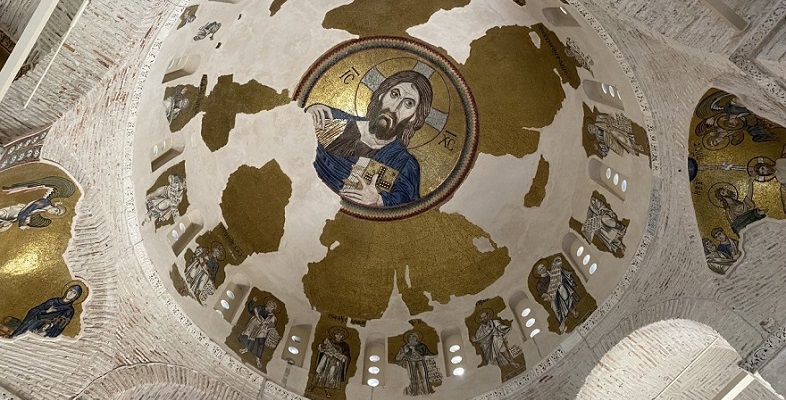3.2.2 Second zone
The second zone mainly features scenes from significant episodes from the Life of Christ, based primarily on the narrative of the New Testament, which is known in Byzantine art as a ‘festival cycle’. The liturgical calendar has a series of feasts, particular celebrations, often of events described in Holy Scripture, and the corresponding images form part of the standard imagery of the church. A popular selection of scenes forming the so-called Dodekaorton (from the Greek Δώδεκα Εορτές, Dṓdeka Eortés, lit. ‘twelve feasts’ – see the downloadable document Appendix 2 [Tip: hold Ctrl and click a link to open it in a new tab. (Hide tip)] for more information) includes:
- the Annunciation to the Virgin
- the Nativity of Christ
- the Presentation of Christ in the Temple
- the Baptism of Christ
- the Transfiguration of Christ
- the Raising of Lazarus
- the Entry into Jerusalem
- the Betrayal of Christ
- the Road to Calvary
- the Crucifixion
- the Anastasis (Harrowing of Hell)
- the Koimesis (Dormition) of the Virgin.
It should be noted, however, that the inclusion and placement of the icons is by no means rigid, or based exclusively upon these scenes; countless variations in number and scene-selection comprising the so-called Dodekaorton exist. The surface of the larger-scale churches with a narthex allows for a lot more than twelve scenes as part of the decoration – but the conventional term Dodekaorton is still equally applied to larger as well as smaller iconographic programmes. Therefore, other popular scenes such as the Last Supper, the Washing of the Feet, the Descent from the Cross, the Lamentation and/or the Entombment of Christ frequently found their way into Byzantine church iconographic programmes.
This second zone also hosts scenes from the life of the patron saint of the church, to whom the church is dedicated. For example, if a church is dedicated to Saint Nicholas, you will encounter scenes that narrate the life of the saint from his birth, his ordination as a priest and bishop and his miracles; if a church is dedicated to Saint George, you will encounter scenes from the saint’s miracles and martyrdom, and so forth. The number of icons conveying the patron saint’s life depends on the availability of space: limited availability is reflected in a handful of scenes, usually the most significant in a saint’s life, while larger spaces allow for more detailed visual narratives.
The common arrangement of the Dodekaorton cycle within the nave of a Byzantine church would, in theory, be a chronological one, starting on the south-eastern side, next to the sanctuary, and terminating on the north-eastern side, again next to the sanctuary, having worked its way clockwise around the church. However, this arrangement was far from set in stone. It is virtually impossible to find two Byzantine churches that display the exact same iconographic programme placed in the exact same positions. This may be related to the fact that the sequence of the scenes in chronological order (i.e., within Christ’s life) does not correspond to the liturgical calendar (e.g., the Entry to Jerusalem that marks the beginning of the Holy Week is celebrated sometime in Spring, while the feast day for the Transfiguration, which took place before the Entry, is 6th August).
